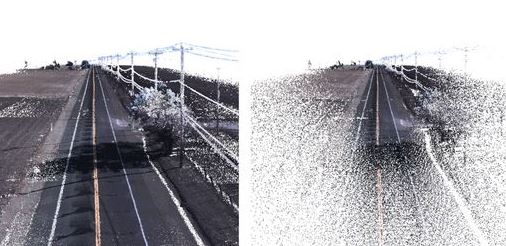We all are well aware of LiDAR and the benefits of LiDAR, if not then spend some time searching out how organizations are turning to LiDAR for high precision 3D and aerial mapping projects. There’s LiDAR centric industry magazines out there (See LiDAR Magazine for example), LiDAR discussion groups, facebook pages, meetups and much more. Mapping companies small and large are all looking at the technology as a solution for creating amazing 3D data products or for simply filling in the gaps in their maps, webmaps, and apps. We explore some options for professionals interested in LiDAR by sharing 10 Software solutions that you might want to consider to help managing, analyzing, and working with LiDAR.

- Rapidlasso LAStools – LAStools is a collection of highly-efficient, scriptable tools with multi-core batching that process LAS, compressed LAZ, Terrasolid BIN, ESRI Shapefiles, and ASCII. this product suite is used heavily used in the commercial sector, government agencies, research labs, and educational institutions alike for filtering, tiling, rasterizing, triangulating, converting, clipping, quality-checking, etc… The company also an has open-source LiDAR compressor tool (award winning) called LASzip for those with a need for compressed LiDAR.
- LiDAR Compressor – The company has a number of fine solutions that will help the LiDAR user be much more productive including their LiDAR Compressor Tool which enables users to reduce LiDAR file sizes by 75 percent or more while retaining all of your points and all of the precision and accuracy of your point data. Also from Lizardtech is their GeoGofer Solution to help locate your LiDAR data.
- LiMo – LiDAR Mobile App – Developed by OGSystems, this is a LiDAR viewing app for android and iOS. The app is available for free on the Google play store and apple iTunes app store. With the app, users can not only view but also manipulate either their own point clouds or download existing data provided by OGSystems servers.
- Global Mapper LiDAR Module – This solution offers the ability to quickly identify and classify building and vegetation points in unclassified LiDAR data, a new tool to automate the feature extraction process for creating 3D vector buildings and trees, and dramatically improved automatic classification of ground points. The LiDAR Module offers an array of post-processing tools that enable the querying, filtering, editing, reclassifying, and exporting of LiDAR data.
- TerraSolid for processing LiDAR data – Terrasolid develops software products that are used for processing LiDAR and image data from airborne and mobile laser scanning systems. TerraSolid products are able to use the pointclouds in a geospatial setting. Terrasolid develops software products that are used world-wide for processing point cloud and image data from airborne and mobile systems.
- LiDAR in ArcGIS – ArcGIS offers many tools for managing lidar point clouds and deriving useful products from them to aid scientific research and decision making. Learn more about Working natively with Lidar data with Esri solutions. Esri has also authored a paper in their ArcNews publication titled 5 Ways to Use Lidar More Efficiently
- RiALITY on iPad from Riegl – This app allows users to experience LiDAR data in a completely new environment. It also allows easier LiDAR data demonstrations through the use of an iPad. RiALITY features true color point clouds and 3D navigation. In a breakthrough technological development, the app features an Augmented Reality Mode. The Augmented Reality Mode allows point clouds to be virtually projected into the real world.
- LP360 – This solution turns ArcMap Basic edition into the world’s most powerful GIS environment for LIDAR point cloud processing. Whether from airborne LIDAR or drone collected imagery, 3D point clouds have become a critical base mapping layer. LP360 provides tools from rapid visualization and derived product generation through advanced features such as automatic ground classification and building footprint extraction.
- Certainty 3D – Software for working with and extracting featured from LiDAR data. Solutions include TopoDot for point cloud data processing, TopoLift to support your laser scanning, and TopoPlanner & TopoMission, free apps to help plan, estimate and manage your scanning projects. Their products address the challenges of data management, quality assessment and extraction of 3D CAD models from LiDAR data.
- Merrick MARS – The Merrick Advanced Remote Sensing (MARS®) software suite is a comprehensive, production-grade Windows application designed to visualize, manage, process and analyze LiDAR point cloud data. The MARS suite includes MARS FreeView (basic LiDAR visualization), MARS Explorer (LiDAR data classification and processing), MARS Explorer QC (automated feature processing), and MARS Production for advanced processing and more.
- BONUS — Safe Software, FME has a number of built in functionality that enables users to process and analyze raster data products. FME can support the transformation of point cloud data into over 300 data formats! Note, Dale Lutz of Safe addressed the topic of LiDAR in a blog post that discussed how Esri was knocking down the barriers to working with LiDAR data via their native support for LAS within ArcGIS at R 10.1.
Lidar (also called LIDAR, LiDAR, and LADAR) is a surveying method that measures distance to a target by illuminating that target with a laser light. The name lidar, sometimes considered an acronym of Light Detection And Ranging (sometimes Light Imaging, Detection, And Ranging), was originally a portmanteau of light and radar. Lidar is popularly used to make high-resolution maps, with applications in geodesy, geomatics, archaeology, geography, geology, geomorphology, seismology, forestry, atmospheric physics, laser guidance, airborne laser swath mapping (ALSM), and laser altimetry. Lidar sometimes is called laser scanning and 3D scanning, with terrestrial, airborne, and mobile applications.